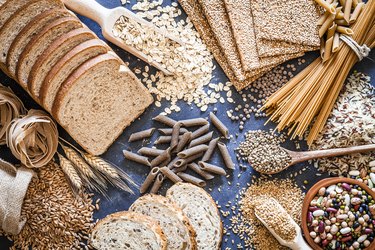
Achieving a muscle pump both during and after a strength training workout is a goal of many serious athletes and bodybuilders. Some companies even claim they have supplements to keep muscles pumped for hours after exercise. Ultimately, though, the muscle pump comes down to how you eat and train.
Tip
Certain training techniques such as drop sets and lifting a lower weight with higher repetitions and minimal rest may help keep the feeling of muscle pump post-workout.
Video of the Day
Muscle Pump Workout
The concept of muscle pump was studied by two researchers, and published in the June 2014 Strength and Conditioning Journal. Muscle pump, they point out, typically refers to cellular swelling because the muscles become engorged with blood during intense muscle contractions.
Video of the Day
Gym-goers and bodybuilders adopted the term "muscle pump" because of how the muscles feel after performing resistance exercises that rely heavily on anaerobic glycolysis that involve moderate to higher repetitions with a lower resistance and limited rest intervals. Based on their research, a muscle pump workout should include various strength training exercises using a high number of repetitions with a low resistance setting. The higher number of repetitions increases heart rate and blood flow to the muscles for an increased pump.
According to the research, bodybuilders looking to achieve the notorious muscle pump may also perform drop sets, which involves doing two to three sets of an exercise at a moderate weight, then immediately dropping the weight and performing a final set, or drop set. For example, when doing bicep curls on a cable machine, perform the first three sets with a moderate weight for a repetition range of 12 to 15. After completing the third set, immediately drop the weight and perform another set of 12 to 15 reps.
Muscle Pump Foods and Drinks
Drinking plenty of water during and after a workout is another way to keep the muscles pumped. That's because staying hydrated helps the heart pump blood through the blood vessels to the muscles, according to the American Heart Association (AHA).
Because hydration needs are dependent on several factors such as type and duration of exercise, weather conditions and certain health conditions, the AHA says the easiest thing to do is pay attention to the color of your urine. If it is dark, you need to drink more fluids. But if you're consistently producing pale and clear urine, you're staying hydrated.
Eating carbs before a workout, and replenishing them after a strength training session, is another strategy that may help with muscle pump. While not necessarily called "muscle pump foods," eating carbohydrates before a workout increases the amount of glycogen stored in your muscles. When this happens, your body also stores a small amount of water, which may give your muscles a more pumped-up appearance.
Additionally, eating carbs after a workout helps replenish the glycogen lost through training. Plus, combined with protein, carbs help rebuild and repair your muscles. Some great choices of pre and post-workout carbohydrates include yams, brown rice, pasta, whole-grain cereals, fruits and vegetables.
Supplements to Keep Muscles Pumped
Store shelves are full of supplements promising bigger gains, faster weight loss and better performance. As far as supplements to keep muscles pumped, it's difficult to say definitively if a supplement will give you a muscle pump.
That said, one supplement that is popular among the weight-lifting community that may give your muscles a pump is creatine. While this is not a guarantee, creatine is often used as a supplement to keep muscles pumped because it increases the water volume in your body, and hence, gives your muscles a feeling of being pumped.
Many people will use creatine to help enhance performance, boost strength and increase lean muscle mass, which a July 2012 study review of creatine published in the Journal of International Society of Sports Nutrition supports. However, it should be noted that this study points out that the benefits of creatine happened when also performing heavy resistance training, rather than resistance training alone.
Even though you can get creatine from foods like red meat and seafood, some people decide to supplement for additional benefits. For the most part, creatine is safe to take as long as you adhere to the appropriate doses, according to the Mayo Clinic. However, there is also evidence suggesting that creatine may be unsafe when taken in large doses and could negatively impact or damage the liver, kidneys or heart.
- Strength and Conditioning Journal: "The Muscle Pump: Potential Mechanisms and Applications for Enhancing Hypertrophic Adaptations"
- American Heart Association: "Staying Hydrated-Staying Healthy"
- The Mayo Clinic: "Creatine"
- Journal of the International Society of Sports Nutrition: "Creatine Supplementation With Specific View to Exercise/Sports Performance: an Update"
- Academy of Nutrition and Dietetics: "Timing Your Pre-and Post-Workout Nutrition"